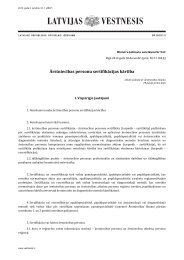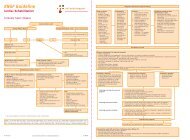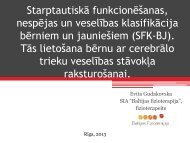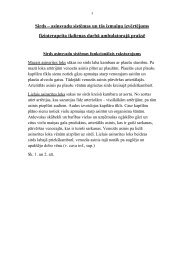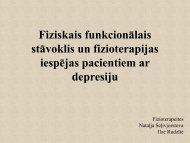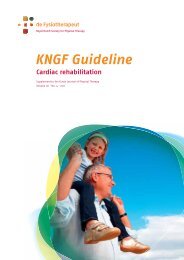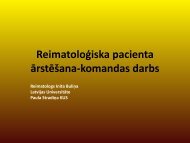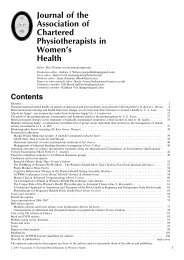Create successful ePaper yourself
Turn your PDF publications into a flip-book with our unique Google optimized e-Paper software.
<strong>Low</strong> <strong>Back</strong> <strong>Pain</strong>: Clinical Practice Guidelines<br />
herniated intervertebral disc at 1 or more levels of the lumbar<br />
spine. Each patient received prone lumbar traction using the<br />
vertebral axial decompression (VAX-D) system for 8 weeks.<br />
The numeric pain rating scale and the Roland-Morris Disability<br />
Questionnaire were completed at preintervention, at<br />
discharge, and at 30 days and 180 days after discharge. A<br />
total of 250 (84.4%) subjects completed the treatment protocol,<br />
so an intention-to-treat analysis was performed to account<br />
for the loss to follow-up. The investigators found that<br />
patients reported significantly improved pain and Roland-<br />
Morris Disability Questionnaire scores after 16 to 24 visits<br />
of prone traction at discharge, and at 30 days and 180 days<br />
postdischarge. It should be noted that there was no control<br />
group and that there were large variations in the magnitude<br />
of change in the outcome measures used.<br />
There is conflicting evidence for the efficacy of in-<br />
D termittent lumbar traction for patients with low<br />
back pain. There is preliminary evidence that a subgroup<br />
of patients with signs of nerve root compression along<br />
with peripheralization of symptoms or a positive crossed<br />
straight leg raise will benefit from intermittent lumbar traction<br />
in the prone position. There is moderate evidence that<br />
clinicians should not utilize intermittent or static lumbar<br />
traction for reducing symptoms in patients with acute or subacute,<br />
nonradicular low back pain or in patients with chronic<br />
low back pain.<br />
PATIENT EDUCATION AND COUNSELING<br />
Education and advice have been traditional interventions<br />
given to patients with acute, subacute,<br />
and chronic low back pain. A survey of recognized<br />
clinical specialists in orthopaedic physical therapy identified<br />
that patient education strategies consisting of “Educate<br />
patient in home care treatment program” and “Recommends<br />
strategies to prevent recurrent problems” ranked as the highest<br />
2 out of a list of 12 intervention strategies. 216 In addition,<br />
“Functional movement training/re-education” was ranked as<br />
a “very important strategy” for therapists to implement in<br />
their plan of care for patients. 216 V<br />
For patients with low back<br />
pain, this commonly involves identifying movements that<br />
are associated with low back pain, such as excessive flexion<br />
of the lumbar spine when rising from a chair instead<br />
of utilizing flexion of the hip for executing the movement,<br />
then providing cuing and education on movement options<br />
that enable the activity to be performed with fewer, or no,<br />
symptoms.<br />
Research in patient education and counseling strategies has<br />
focused on 3 main approaches: (1) general education and advice<br />
in acute and subacute populations; (2) behavioral education,<br />
including cognitive-behavioral theory, graded activity,<br />
a38 | april 2012 | volume 42 | number 4 | journal of orthopaedic & sports physical therapy<br />
and graded exposure, in a variety of populations; and (3)<br />
education of patients on the physiology of pain.<br />
Previous clinical practice guidelines generally recommend<br />
clinicians to counsel their patients to (1)<br />
remain active, (2) avoid bed-rest, and (3) acknowledge<br />
the positive natural history of acute low back pain.<br />
For example, the joint guidelines for the “Diagnosis and<br />
Treatment of <strong>Low</strong> <strong>Back</strong> <strong>Pain</strong>” from the American College<br />
of Physicians and the American <strong>Pain</strong> Society state, “Clinicians<br />
should provide patients with evidence-based information<br />
on low back pain with regard to their expected course,<br />
advise patients to remain active, and provide information<br />
about effective self-care options (strong recommendation,<br />
moderate-quality evidence).” 56 Several other systematic<br />
reviews have demonstrated moderate evidence for advising<br />
patients to remain active, as compared to bed-rest,<br />
for the best opportunity for pain reduction and functional<br />
improvements. 77,134,158<br />
I<br />
In 2007, Liddle et al198 published a systematic re-<br />
I view on advice for the management of low back<br />
pain. Major findings stated that general instructions<br />
to remain active are sufficient for patients with acute<br />
low back pain. More involved education relating to appropriate<br />
exercise and functional activities to promote active<br />
self-management is effective in patients with subacute and<br />
chronic low back pain.<br />
Burton et al39 completed a randomized controlled<br />
I trial (n = 162) exploring the efficacy of a novel<br />
educational booklet compared with a traditional<br />
booklet in patients with low back pain being seen in a primary<br />
care setting. Traditional information and advice about<br />
back pain have been based on a biomedical model with emphasis<br />
on anatomy, biomechanics, and pathology. The novel<br />
education booklet de-emphasized education on pathology<br />
and disease processes, provided reassurance regarding the<br />
likelihood of recovery, and promoted positive attitudes. The<br />
novel education booklet resulted in significantly greater early<br />
improvement in beliefs that were maintained at 1 year. For<br />
patients who had elevated fear-avoidance beliefs, there was a<br />
clinically important improvement in the Roland-Morris Disability<br />
Questionnaire at 3 months.<br />
Coudeyre et al71 demonstrated in a large, nonran-<br />
III<br />
domized controlled trial that utilization of pamphlet<br />
education was effective in reducing persistent<br />
low back pain and increasing patient satisfaction. Days of<br />
work missed, disability as measured by the Quebec Disability<br />
Scale, and fear-avoidance beliefs did not differ between<br />
the groups who received or did not receive the educational<br />
pamphlet.



